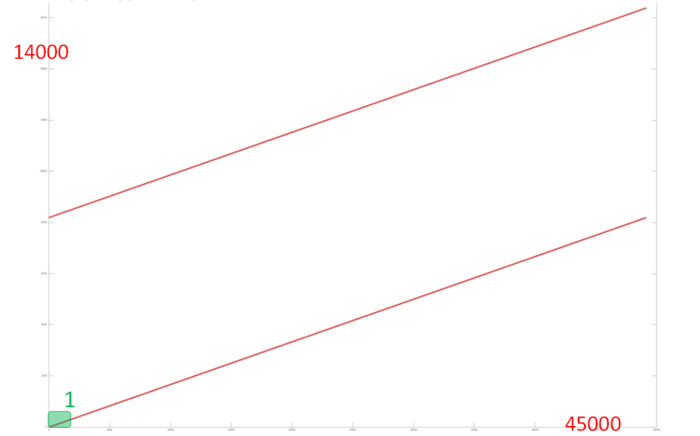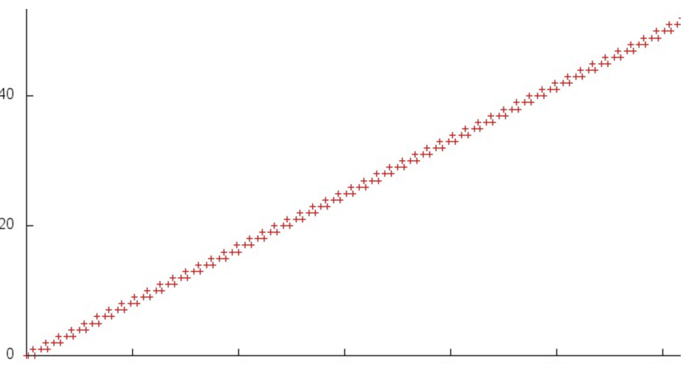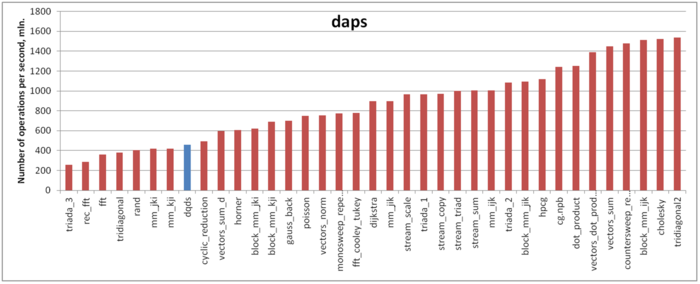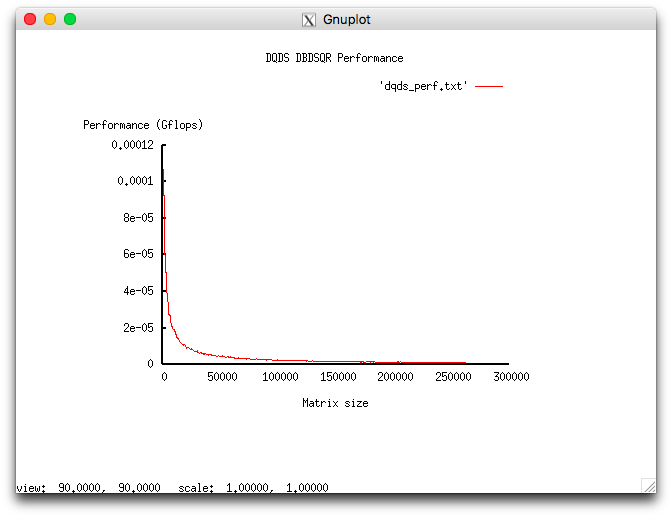Difference between revisions of "One step of the dqds algorithm"
| [unchecked revision] | [unchecked revision] |
| Line 166: | Line 166: | ||
=== Locality of data and computations === | === Locality of data and computations === | ||
| − | + | It is easy to see that the data locality is high. It can be further improved by placing alongside the corresponding elements of the arrays e и q. однако, это не оказывает существенного влияния на производительность в силу константного количества операций относительно объема обрабатываемых данных. | |
==== Locality of implementation ==== | ==== Locality of implementation ==== | ||
Revision as of 11:40, 29 October 2017
| Алгоритм dqds нахождения сингулярных чисел двухдиагональной матрицы | |
| Sequential algorithm | |
| Serial complexity | [math]5n-4[/math] |
| Input data | [math]2n[/math] |
| Output data | [math]2n[/math] |
| Parallel algorithm | |
| Parallel form height | [math]4n-3[/math] |
| Parallel form width | [math]2[/math] |
Primary authors of this description: A.Yu.Chernyavskiy
Contents
- 1 Properties and structure of the algorithm
- 1.1 General description of the algorithm
- 1.2 Mathematical description of the algorithm
- 1.3 Computational kernel of the algorithm
- 1.4 Macro structure of the algorithm
- 1.5 Implementation scheme of the serial algorithm
- 1.6 Serial complexity of the algorithm
- 1.7 Information graph
- 1.8 Parallelization resource of the algorithm
- 1.9 Input and output data of the algorithm
- 1.10 Properties of the algorithm
- 2 Software implementation of the algorithm
- 2.1 Implementation peculiarities of the serial algorithm
- 2.2 Locality of data and computations
- 2.3 Possible methods and considerations for parallel implementation of the algorithm
- 2.4 Scalability of the algorithm and its implementations
- 2.5 Dynamic characteristics and efficiency of the algorithm implementation
- 2.6 Conclusions for different classes of computer architecture
- 2.7 Existing implementations of the algorithm
- 3 References
1 Properties and structure of the algorithm
1.1 General description of the algorithm
The dqds algorithm iteration implements one step of the dqds algorithm for calculating the singular values of a bi-diagonal matrix.
The full dqds algorithm (differential quotient-difference algorithm with shifts)[1][2] constructs a sequence of bi-diagonal matrices that converges to a diagonal matrix containing the squares of the required singular values. It has the merit of calculating the singular values to high accuracy.
The computational kernel of the algorithm is its inner iteration. Outside of the iterations, shifts [math]\delta[/math] (iteration parameters, see mathematical description of the algorithm) are chosen, convergence is looked after, and various optimization tricks are applied. Note that the non-iterative part of the algorithm is not important with respect to the structure of calculations because the main computational costs fall on the calculations within the iterations. Details concerning the non-iterative part, its variants, and the analysis of convergence can be found in the related literature [3] [4] [5].
1.2 Mathematical description of the algorithm
1.2.1 Auxiliary information
In order to understand the mathematical background of dqds iteration, it is helpful to briefly discuss its derivation, which, to same extent, reflects the history of the algorithm (the details can be found in [1]). It is convenient to begin with the so-called LR iteration, which predates the well-known QR iteration. Starting from the initial symmetric positive definite matrix [math]T_0\gt [/math], the LR algorithm constructs a converging sequence of matrices [math]T_i\gt 0[/math] that are similar to [math]T_0[/math]. In this construction, the following three steps are used iteratively:
- Choose a shift [math]\tau_i[/math] that is less than the smallest eigenvalue of the matrix [math]T_i.[/math]
- Compute the Cholesky decomposition [math]T_i-\tau^2_iI=B_i^TB_i,[/math] where [math]B_i[/math] is an upper triangular matrix with a positive diagonal.
- [math]T_{i+1}=B_iB_i^T+\tau_i^2I.[/math]
Note that two steps of LR iteration with a zero shift are equivalent to a single step of QR iteration. This iterative procedure brings the matrix to diagonal form, calculating thereby the eigenvalues of the original matrix. It is easy to reformulate the LR algorithm for the problem of calculating the singular values of bi-diagonal matrices, and, for this problem, the algorithm becomes noticeably simpler. Namely, let us calculate a sequence of bi-diagonal matrices [math]B_i[/math] avoiding a direct calculation of matrices [math]T_i[/math] (which, in this case, are tri-diagonal). Let [math]B_i[/math] have the diagonal entries [math]a_1 \ldots a_n[/math] and the super-diagonal entries [math]b_1 \ldots b_{n-1}[/math], while [math]B_{i+1}[/math] has the diagonal entries [math]\widehat{a}_1 \ldots \widehat{a}_n[/math] and the super-diagonal entries [math]\widehat{b}_1 \ldots \widehat{b}_{n-1}.[/math] Then, in terms of the matrices [math]B_i[/math], one step of LR iteration can be reduced to a simple loop over [math]j[/math] running from [math]1[/math] to [math]n-1:[/math]
- [math] \widehat{a}^2_j = a^2_j+b^2_j-\widehat{b}^2_{j-1}-\delta [/math]
- [math] \widehat{b}^2_j = b^2_j\dot (a^2_{j+1}/a^2_j), [/math]
which is completed by the calculation of [math]\widehat{a}^2_n = a^2_n-\widehat{b}^2_{n-1}-\delta.[/math] The extraction of square roots is obviously better to postpone until the algorithm terminates; hence, one can set [math]q_j=a^2_j,\; e_j=b^2,[/math] which ultimately yields the so-called qds algorithm. It is given by the following formulas:
- [math] \widehat{q}_j = q_j + e_j - \widehat{e}_{j-1} - \delta, \quad j \in [1,n-1] [/math]
- [math] \widehat{e}_j = e_j \cdot q_{j+1} / \widehat{q}_j, \quad j \in [1,n-1] [/math]
- [math] \widehat{q}_n = q_n - \widehat{e}_{n-1} - \delta. [/math]
Here, </math> [math]q_j, \; j \in [1,n][/math] and [math]e_j, \; j \in [1,n-1][/math] are the squares of the diagonal and super-diagonal entries, respectively. The circumflexes mark the output variables, and the symbol [math]\delta[/math] denotes the shift (which is a parameter of the algorithm). This is the most compact formulation of the so-called qds iteration.
1.2.2 Mathematical description of dqds iteration
Let us give the mathematical formulation of dqds iteration (from a mathematical viewpoint, qds and dqds iterations are equivalent), using the auxiliary variables [math]t_j[/math] and [math]d_j.[/math] One dqds iteration transforms the input bi-diagonal matrix [math]B[/math] to the output matrix [math]\widehat{B}.[/math]
Input and output data: [math]q_{j}, \; j\in [1,n], \; e_{k}, \; k\in [1,n-1] [/math] are the squares of the diagonal and super-diagonal entries of the input matrix [math]B[/math]; [math] \widehat{q}_j , \; \widehat{e}_k [/math] have the same meaning for the matrix [math]\widehat{B}[/math] to be calculated.
The method is given by the following formulas:
- [math] d_1 = q_1 - \delta, \; q_n = d_n [/math]
- для[math] \quad j\in [1,n-1]: [/math]
- [math] \widehat{q}_j = d_j + e_j [/math]
- [math] t_j = q_{j+1}/\widehat{q}_j [/math]
- [math] \widehat{e}_j=e_j \cdot t_j [/math]
- [math] d_{j+1} = d \cdot t - \delta [/math]
1.3 Computational kernel of the algorithm
The computational kernel of the algorithm consists in the successive calculation of the squares of the diagonal ([math]\widehat{q}_j[/math]) and super-diagonal ([math]\widehat{e}_k[/math]) entries of the output matrix. In view of the use of auxiliary variables, the calculation of each new pair requires one addition, one subtraction, one division, and two multiplications.
1.4 Macro structure of the algorithm
The algorithm consists of the separate calculation of the initial value of the auxiliary variable [math]d[/math], the subsequent execution (repeated (n-1) times) of the sequence of 5 operations (+,/,*,*,-) for calculating the squares of the diagonal ([math]\widehat{q}_j[/math]) and super-diagonal ([math]\widehat{e}_k[/math]) entries of the output matrix, and the concluding calculation of the last value [math]\widehat{q}_n[/math].
1.5 Implementation scheme of the serial algorithm
Note that the output data can right away be written to the locations of the old data (which is used in the scheme). To store the auxiliary variables [math]t_j[/math] and [math]d_j[/math], it is sufficient to have two rewritable variables. Thus, the diagonal ([math]q_j[/math]) and super-diagonal ([math]e_k[/math]) entries of the input matrix are successively replaced by the corresponding entries of the output matrix.
The operations in the method are performed in the following order:
1. Compute the initial value of the auxiliary variable [math]d = q_1-\delta.[/math]
2. Perform a loop over j from 1 to n-1. It consists of the following:
- 2.1 Compute the value [math]q_j = d + e_j;[/math]
- 2.2 Compute the value of the auxiliary variable [math]t = q_{j+1}/q_j;[/math]
- 2.3 Compute the value [math]e_j = e_j \cdot t;[/math]
- 2.4 Compute the value of the auxiliary variable [math]d = d \cdot t - \delta.[/math]
3. Compute [math]q_n = d.[/math]
These calculations can be organized in a different form, for instance, in the form of qds iteration (see Mathematical description of dqds iteration). However, it is dqds implementation that makes it possible to attain high accuracy [1].
1.6 Serial complexity of the algorithm
In order to perform one dqds iteration, it is necessary to execute
- [math]n-1[/math] divisions,
- [math]2n-2[/math] multiplications,
- [math]2n-1[/math] additions/subtractions.
Thus, one dqds iteration has a linear complexity.
1.7 Information graph
1.8 Parallelization resource of the algorithm
The information graph of the algorithm shows that, at each step of the main loop, only multiplication (2.2) and multiplication + addition (2.4) can be executed in parallel. This makes it possible to reduce the number of layers per loop iteration from 5 to 4 and the overall number of layers in the algorithm from 5n-4 to 4n-3. The layers with multiplications contain two operations, while the other layers contain only one operation.
1.9 Input and output data of the algorithm
Input data: The squares of the diagonal and super-diagonal entries of the input bi-diagonal matrix (the vector [math]q[/math] of length n and the vector [math]e[/math] of length n-1) and the shift parameter [math]\delta[/math].
Size of the input data: [math]2n[/math].
Output data: The squares of the diagonal and super-diagonal entries of the output bi-diagonal matrix.
Size of the output data: [math]2n-1[/math].
1.10 Properties of the algorithm
If the parallel execution of multiplications is possible, then the ratio of the serial to parallel complexity is [math]\frac{5n-4}{4n-3}[/math], that is, the algorithm is poorly parallelizable.
The computational power of the algorithm, understood as the ratio of the number of operations to the total size of the input and output data, is a constant.
The algorithm is completely determined.
2 Software implementation of the algorithm
2.1 Implementation peculiarities of the serial algorithm
In the Matlab language, the algorithm can be written as follows:
d = q(1)-delta;
for j = 1:n-1
q(j)=d+e(j);
t=q(j+1)/q(j);
e(j) = e(j)*t;
d = d*t-delta;
end
q(n) = d;
As already said in the section Implementation scheme of the serial algorithm, the calculated values are written to the locations of the input data.
2.2 Locality of data and computations
It is easy to see that the data locality is high. It can be further improved by placing alongside the corresponding elements of the arrays e и q. однако, это не оказывает существенного влияния на производительность в силу константного количества операций относительно объема обрабатываемых данных.
2.2.1 Locality of implementation
2.2.1.1 Structure of memory access and a qualitative estimation of locality
На рис. 2 представлен профиль обращений в память для реализации итерации алгоритма dqds. Данный профиль внешне устроен очень просто и состоит из двух параллельно выполняемых последовательных переборов. Отметим, что общее число обращений в память всего в 3 раза больше числа задействованных данных, что говорит о том, что данные повторно используют редко. Зачастую это сигнализирует о достаточно невысокой локальности.
Рассмотрим более детально строение одного из переборов (второй устроен практически идентично). На рис. 3 показан выделенный на рис. 2 небольшой фрагмент 1. Видно, что на каждом шаге в данном переборе выполняется три обращения в память; подобное строение говорит о высокой пространственной локальности, однако низкой временной, поскольку данные повторно используются только по 3 раза.
Поскольку данная структура обращений и составляет общий профиль, то же самое можно говорить и о локальности всего профиля.
2.2.1.2 Quantitative estimation of locality
Оценка выполняется на основе характеристики daps, которая оценивает число выполненных обращений (чтений и записей) в память в секунду. Данная характеристика является аналогом оценки flops применительно к работе с памятью и является в большей степени оценкой производительности взаимодействия с памятью, чем оценкой локальности. Однако она служит хорошим источником информации, в том числе для сравнения с результатами по следующей характеристике cvg.
На рисунке 4 приведены значения daps для реализаций распространенных алгоритмов, отсортированные по возрастанию (чем больше daps, тем в общем случае выше производительность). Результат получен достаточно неожиданный – производительность работы с памятью очень невелика. Оценка daps для данного профиля сравнима с реализациями самых неэффективных алгоритмов в части работы с памятью – тестов RandomAccess и неэффективных вариантов обычного перемножения матриц. Отчасти это может объясняться низкой временной локальностью. Однако в данном случае причина может также заключаться в том, что в данной реализации объем вычислений на одно обращение в память достаточно велик, что может приводить к недостаточной загруженности подсистемы памяти. В таком случае, несмотря на в целом неплохую эффективность работы с памятью, производительность будет достаточно низка.
2.3 Possible methods and considerations for parallel implementation of the algorithm
Итерация dqds практически полностью последовательна. Единственная возможность - одновременное выполнение операции умножения (2.3) и операции (2.4) умножения и сложения, что дает небольшой выигрыш в производительности.
2.4 Scalability of the algorithm and its implementations
Алгоритм не является масштабируемым, максимального эффекта ускорения можно добиться на двух независимых процессорах.
Проведём исследование масштабируемости вширь реализации согласно методике. Исследование проводилось на суперкомпьютере "Ломоносов-2" Суперкомпьютерного комплекса Московского университета.
Набор и границы значений изменяемых параметров запуска реализации алгоритма:
- число процессоров 1;
- размер матрицы [1000 : 260000] с шагом 500.
В результате проведённых экспериментов был получен следующий диапазон эффективности реализации алгоритма:
- минимальная эффективность реализации 2.559e-06%;
- максимальная эффективность реализации 2.492e-08%.
На следующих рисунках приведены графики производительности и эффективности выбранной реализации DQDS в зависимости от изменяемых параметров запуска.
Исследованная параллельная реализация на языке C
2.5 Dynamic characteristics and efficiency of the algorithm implementation
2.6 Conclusions for different classes of computer architecture
Эффективное выполнение алгоритма возможно только на вычислительных устройствах с одним или двумя ядрами.
2.7 Existing implementations of the algorithm
Сам алгоритм dqds реализован в функции xBDSQR пакета LAPACK и используется при её вызове без расчёта сингулярных векторов.
3 References
- ↑ 1.0 1.1 1.2 Деммель Д. Вычислительная линейная алгебра. – М : Мир, 2001.
- ↑ Hogben L. (ed.). Handbook of linear algebra. – CRC Press, 2006.
- ↑ Fernando K. V., Parlett B. N. Accurate singular values and differential qd algorithms //Numerische Mathematik. – 1994. – Т. 67. – №. 2. – С. 191-229.
- ↑ Parlett B. N., Marques O. A. An implementation of the dqds algorithm (positive case) //Linear Algebra and its Applications. – 2000. – Т. 309. – №. 1. – С. 217-259.
- ↑ Aishima K. et al. On convergence of the DQDS algorithm for singular value computation //SIAM Journal on Matrix Analysis and Applications. – 2008. – Т. 30. – №. 2. – С. 522-537.





